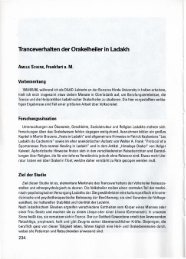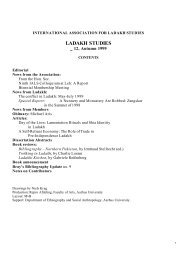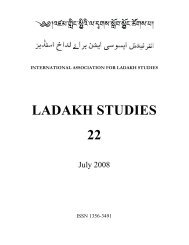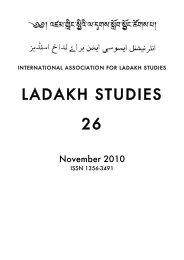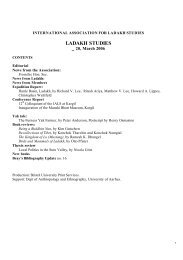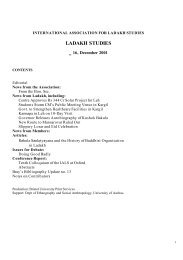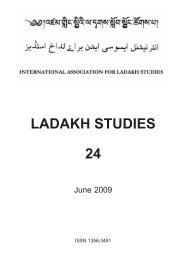LADAKH STUDIES 14, Autumn 2000 - International Association for ...
LADAKH STUDIES 14, Autumn 2000 - International Association for ...
LADAKH STUDIES 14, Autumn 2000 - International Association for ...
You also want an ePaper? Increase the reach of your titles
YUMPU automatically turns print PDFs into web optimized ePapers that Google loves.
SNOWSHOES AND SLEDGES<br />
Extract from “A Winter Journey from Leh to Amritsar” by Brother H. Francke 1<br />
(Herrnhut Magazine nrs 38, 39, and 41, September and October 1897).<br />
Translated and introduced by Gabriele Reifenberg<br />
From time to time there has been talk in Ladakh of winter sports as part of the “adventure holidays”<br />
scene. Here we have an account of a nineteenth-century attempt to use snow sports equipment in<br />
Ladakh.<br />
In his article, August Hermann Francke was writing to the Moravian Brotherhood’s centre at<br />
Herrnhut in Germany to describe a journey full of dangers that he made to meet his fiancée in<br />
Amritsar. He set off from Leh with one servant and a pony on 1 March 1897, taking a minimum of<br />
equipment. Everywhere, including the 250 mile-long track they had to complete, was covered in<br />
snow. It took the two men six days to reach Kargil. At Kargil Francke’s servant insisted that they<br />
could not take the pony any further. Two porters (coolies in the text) were hired to help the<br />
travellers on the next stage of their journey to Kharbu, a small village on the eastern bank of the<br />
Dras river, about four miles from Tashgarn, also known as Tashgam, a village in the Dras valley on<br />
the western bank of the Dras, or Tasgam river, 15 miles north east of Dras.<br />
They reached here after ten hours, covering just 1.5 miles an hour and were totally exhausted.<br />
The next day, although it was still snowing heavily they continued to Tashgarn arriving there in the<br />
evening. They were both very depressed and felt quite hopeless, but Francke decided that he would<br />
prefer to die in a snowstorm rather than be buried alive in the dismal shelter they had found. So he<br />
asked the headman of the village to find two more porters to help them on their way the next day.<br />
The story continues:<br />
We were on the point of setting off again when the coolies fell on their knees, lifted their<br />
hands as in prayer and pleaded stridently: “Have mercy on us, dear Sahib, and do not <strong>for</strong>ce<br />
us to proceed today. Even if we defy the storm we will surely be buried in a snowdrift.” I<br />
looked sternly at the poor men, ordered them to obey, and thus our day's work began. There<br />
was not one sign of a track, just a huge expanse of snow be<strong>for</strong>e us and a thick shower of<br />
snowflakes falling on us. So as to set a good example I went first, jumped into the snow and<br />
saw that, because of its softness, it came up to my knees. I stumbled <strong>for</strong>ward, fell down,<br />
disappeared completely, stood up again, fell down once more and in this way succeeded in<br />
taking five steps in five minutes. My servants did not move from the spot, so I had to<br />
complete the struggle by myself. Totally beaten, I returned to my faithless followers. I felt<br />
like Napoleon at Waterloo!<br />
Don't think, however, that I retreated to the inn with an air of utter defeat. On the contrary,<br />
I felt as though there was something of victory in my bearing and that I held my head high.<br />
How was that possible? Two great new thoughts had flashed into my brain and I was sure<br />
that if they could be realised we would triumph splendidly over our difficulties. The first<br />
thought was to make a pair of Norwegian snowshoes, and the second: a sledge. It was<br />
1 August Hermann Francke, Moravian missionary, arrived in Leh in 1896 direct from Germany.<br />
31




